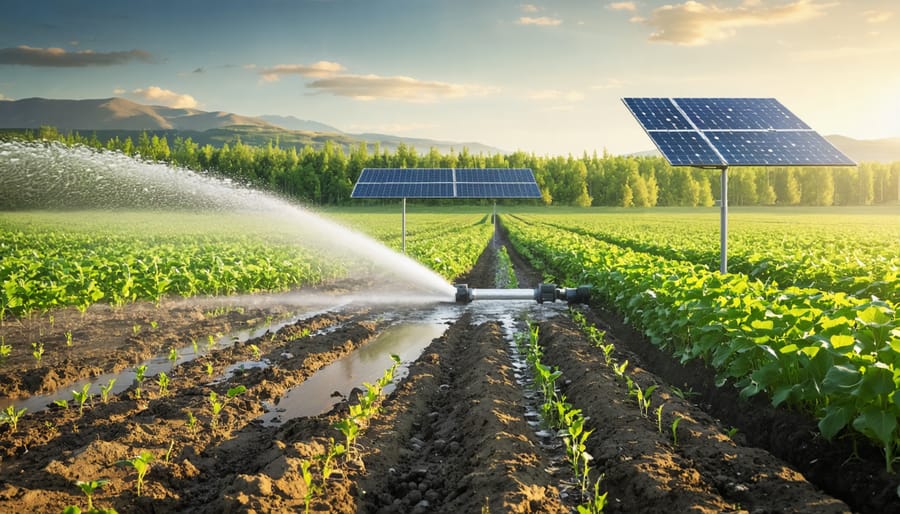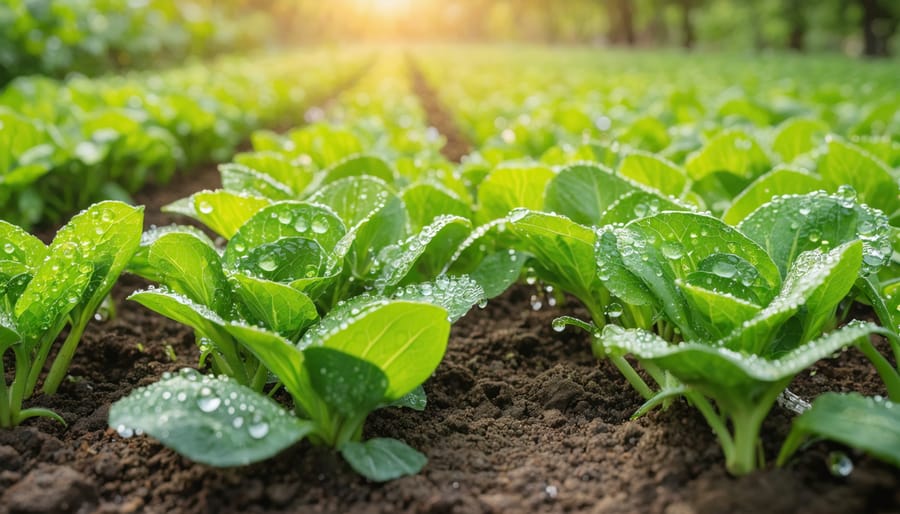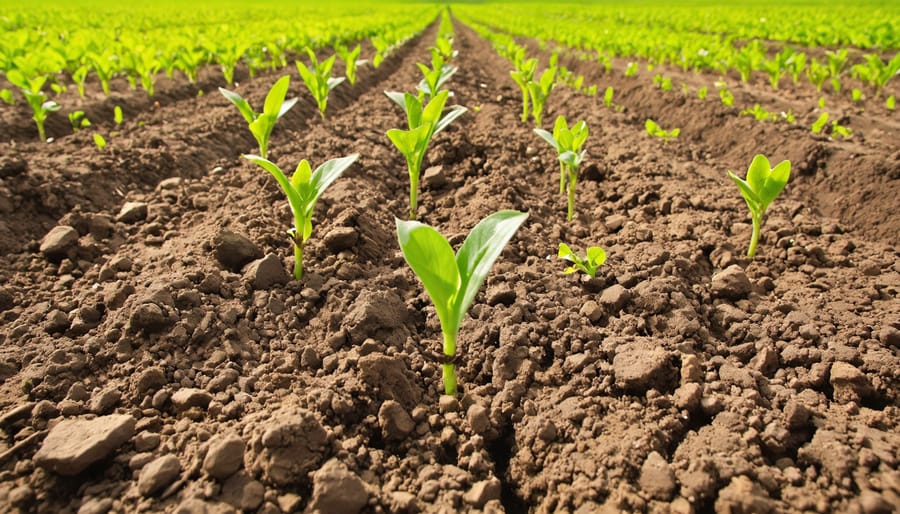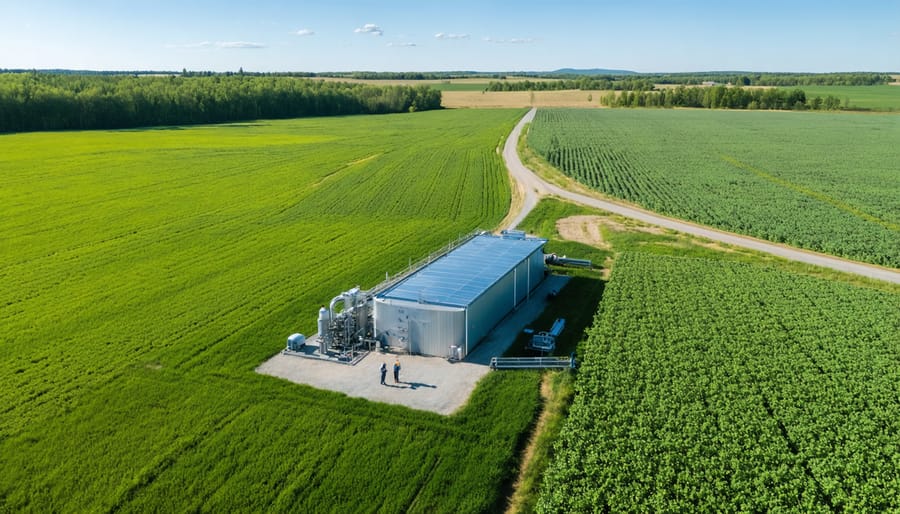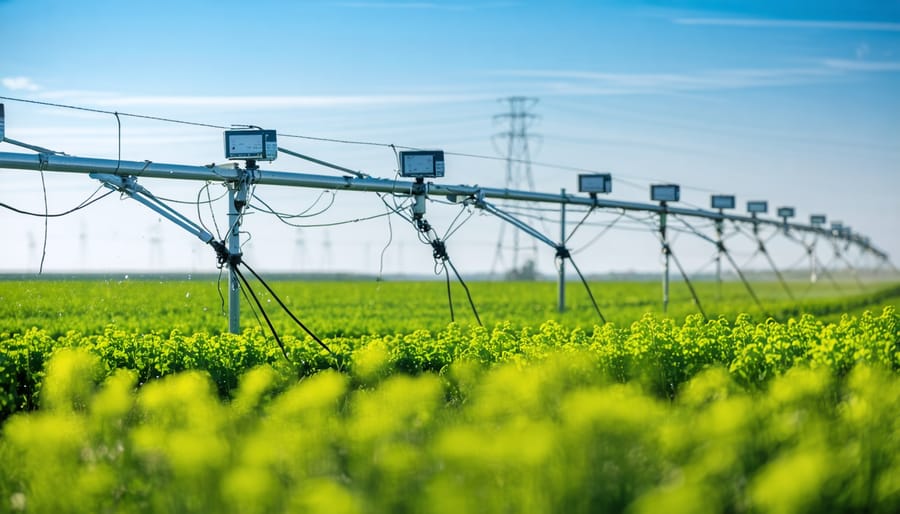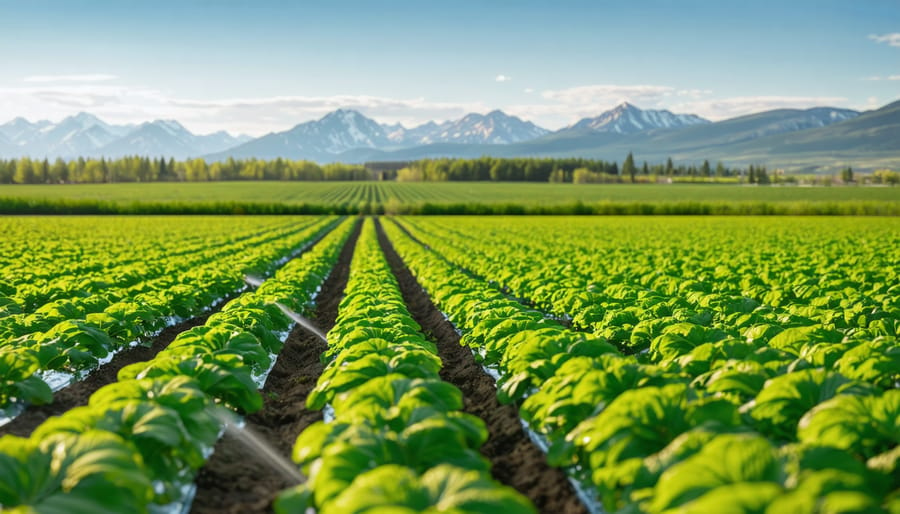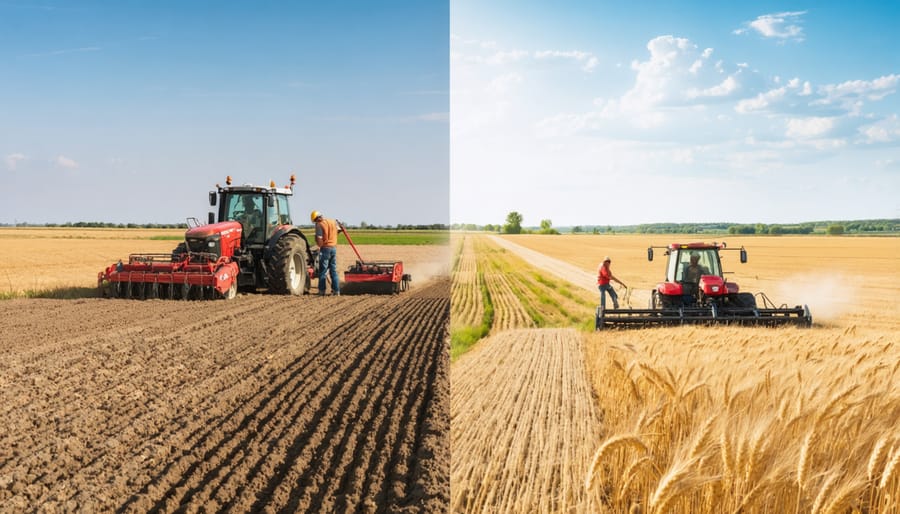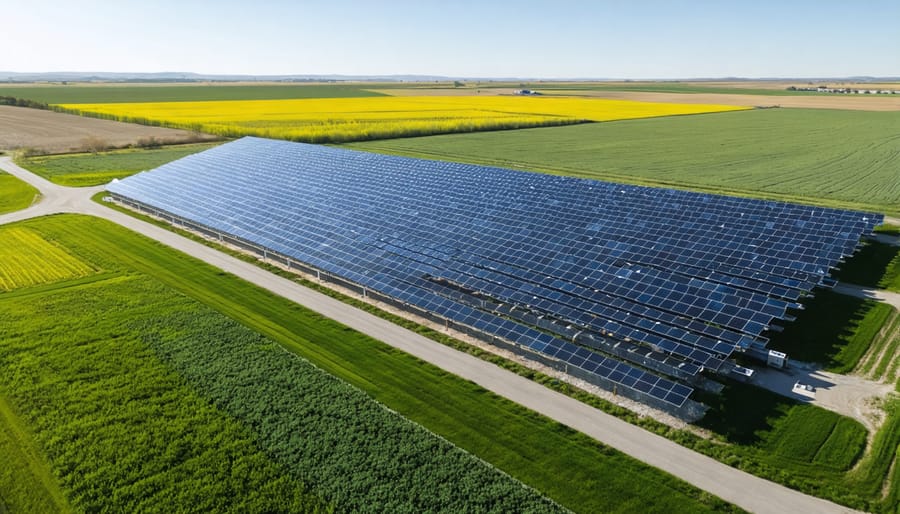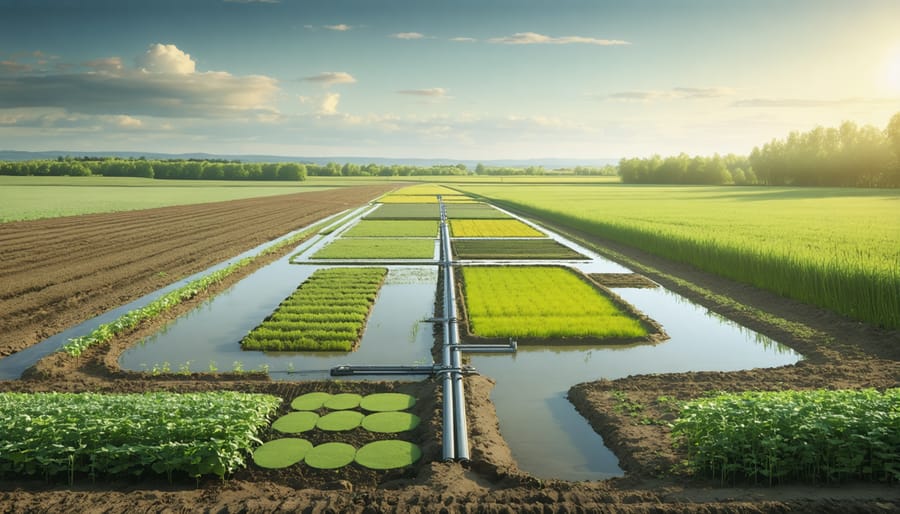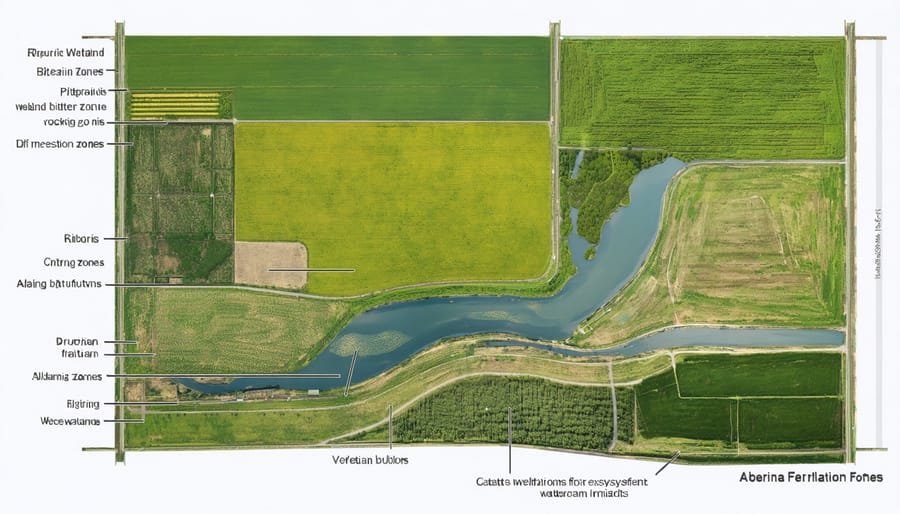Transform your farm’s carbon footprint through proven water management strategies that are already delivering results across Alberta’s agricultural landscape. Installing efficient irrigation systems reduces both water consumption and energy use by up to 30%, while precision soil moisture monitoring helps optimize water application timing and prevents unnecessary pumping costs. Leading Alberta producers have cut their carbon emissions by implementing these practical solutions while maintaining or increasing crop yields.
Smart water management represents one of the most effective ways for Canadian farmers to reduce greenhouse gas emissions while protecting their bottom line. From small-scale vegetable operations to large grain producers, water-efficient practices consistently deliver dual benefits: decreased carbon output from reduced pumping requirements and lower operational costs through optimized resource use. The most successful operations combine these strategies with soil health improvements, creating a comprehensive approach to sustainable agriculture that works in our unique prairie conditions.
As extreme weather events become more frequent, implementing these water management solutions isn’t just about environmental stewardship – it’s about building resilient farm operations that can thrive in changing conditions while contributing to Canada’s carbon reduction goals.
Water-Carbon Connection: Why It Matters for Alberta Farms
Energy Costs of Water Management
Water management on farms can be surprisingly energy-intensive, with irrigation systems often being one of the biggest power consumers in agricultural operations. A typical Alberta farm’s irrigation pump running on electricity uses between 20-30 kilowatt-hours per hectare daily during peak season. For farms using diesel-powered pumps, this translates to roughly 2-3 litres of fuel per hectare per day.
Looking at the complete water system, energy costs typically break down as follows: pumping operations account for about 65% of total energy use, water treatment systems use roughly 20%, and distribution systems consume the remaining 15%. For a mid-sized farm of 400 hectares, this can mean annual energy costs of $15,000-$20,000 just for water management.
Many Alberta farmers have found success in reducing these costs through simple adjustments. Regular maintenance of pumps and pipes can improve efficiency by up to 25%. Installing pressure regulators and timing systems helps manage water flow more effectively, while leak detection and repair can save both water and energy. Modern variable frequency drives (VFDs) on pumps have shown to reduce energy consumption by 30-50% in many cases.
Hidden Carbon Sources in Water Systems
Many farmers are surprised to learn about the significant hidden water costs associated with their irrigation and water management systems. From pumping stations to treatment facilities, these systems generate substantial indirect carbon emissions that often go unnoticed. In Alberta, the energy required to operate water infrastructure typically accounts for 30-40% of a farm’s total electricity consumption.
Traditional water systems rely heavily on grid electricity for pumping, treatment, and distribution. Even seemingly simple operations like maintaining water pressure in irrigation lines can contribute significantly to your farm’s carbon footprint. For example, a typical quarter section pivot irrigation system can consume up to 50,000 kWh annually, equivalent to the energy use of four average Canadian homes.
The good news is that identifying these emission sources is the first step toward reduction. Many Alberta farmers are now implementing energy-efficient pumps, gravity-fed systems where possible, and solar-powered irrigation solutions to address these hidden emissions while maintaining productive operations.
Proven Water-Smart Technologies Reducing Alberta Farm Emissions
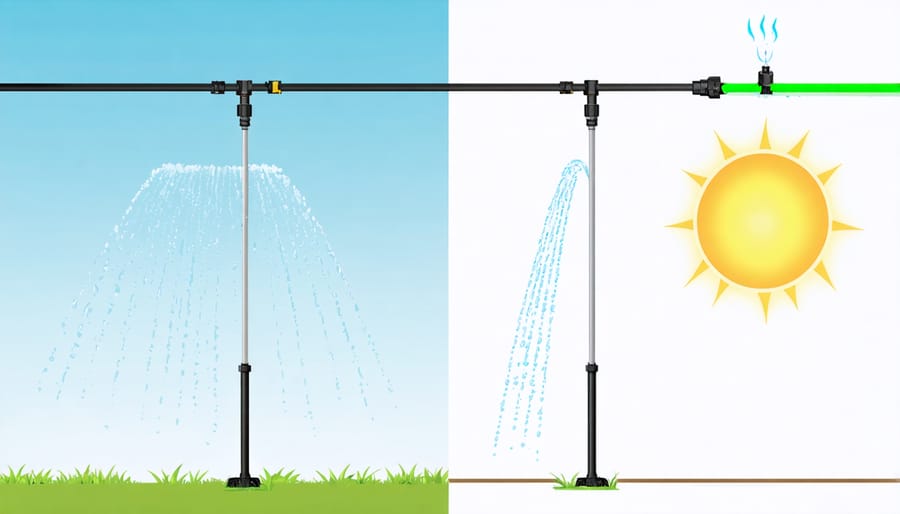
Smart Irrigation Systems
The adoption of smart irrigation systems across Alberta has demonstrated impressive results in both water conservation and carbon reduction. Take the case of Sarah Thompson’s 800-hectare farm near Lethbridge, where implementing soil moisture sensors and automated irrigation controls reduced water usage by 40% and decreased energy consumption for pumping by 35% in the first year alone.
In the Peace River region, the Miller Family Farm integrated weather-based irrigation scheduling with their existing pivot systems. Using real-time climate data and soil moisture readings, they’ve cut their irrigation-related emissions by 28% while maintaining optimal crop yields. Their system automatically adjusts watering schedules based on precipitation forecasts and actual soil conditions.
Another success story comes from Red Deer County, where a group of five neighbouring farms collaborated on a shared smart irrigation network. By coordinating their water usage through interconnected systems, they’ve collectively reduced their carbon footprint by 25% and saved approximately 100,000 kilowatt-hours in pumping energy annually.
These systems typically pay for themselves within 2-3 growing seasons through reduced water and energy costs. Local agricultural extension offices offer guidance and support for farmers interested in transitioning to precision irrigation technology, including information about available grants and technical assistance programs.
Low-Energy Water Distribution
Water distribution on farms traditionally requires significant energy input, but innovative low-energy solutions are making waves across Alberta. Gravity-fed systems, which utilize natural elevation differences, are gaining popularity among farmers in rolling terrain areas. These systems channel water from elevated storage tanks or natural water sources to lower-lying fields, eliminating the need for electric pumps.
Take the Morrison family farm near Red Deer, for example. By restructuring their irrigation layout to take advantage of a 15-metre elevation difference, they’ve reduced their energy consumption by 40% while maintaining consistent crop hydration. Their system uses strategically placed holding ponds that fill naturally during spring runoff.
Solar-powered pumping systems offer another energy-efficient solution, particularly effective during Alberta’s sun-rich summer months. These systems can be scaled to match your needs, from small greenhouse operations to larger field irrigation networks. The Watershed Stewardship Group in Lethbridge reports that farmers using solar-powered irrigation systems save an average of $2,000 annually on energy costs while reducing their carbon footprint.
For optimal results, many farmers combine both approaches, using gravity-fed systems as their primary method and solar-powered pumps as backup during peak demand periods.
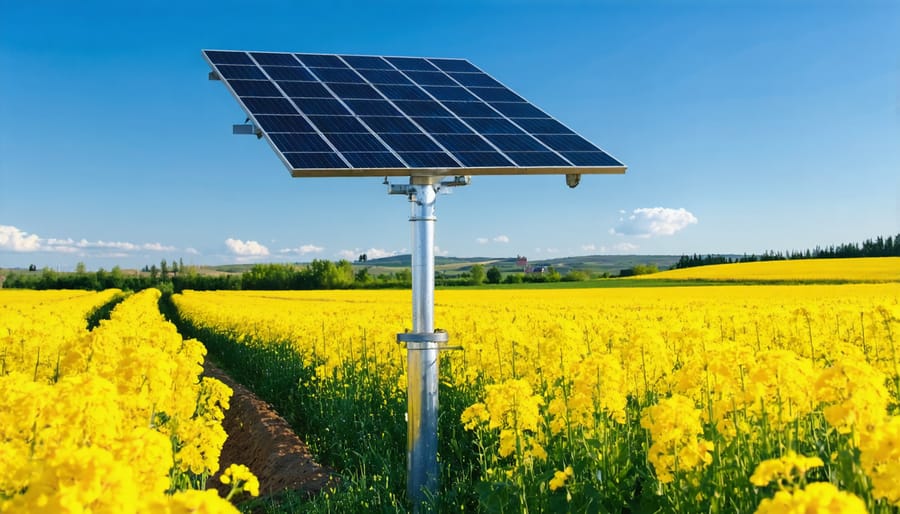
Water Recycling Solutions
Water recycling systems are becoming increasingly vital for Alberta farms, offering both environmental benefits and cost savings. By implementing these systems, farmers can reduce their water consumption by up to 40% while maintaining optimal crop yields and livestock care.
A great example is the Thompson Family Farm near Red Deer, which installed a closed-loop irrigation system that captures and filters runoff water for reuse. Within two years, they reduced their groundwater withdrawal by 50% and saw a 30% decrease in their energy costs related to water pumping.
Key water recycling solutions include installing rainwater harvesting systems, implementing greywater recovery systems for equipment washing, and utilizing advanced filtration technology for livestock watering systems. These solutions not only conserve water but also reduce the energy needed for pumping and treatment, directly impacting your farm’s carbon footprint.
Many Alberta farmers are now using soil moisture sensors and weather monitoring systems to optimize their irrigation scheduling. Combined with water recycling, these tools help prevent over-irrigation and reduce energy consumption. Local agricultural extension offices offer support in planning and implementing these systems, with some regions providing cost-sharing programs for installation.
Simple Steps for Immediate Carbon Reduction
Maintenance and Efficiency Checks
Regular maintenance is your first line of defense in reducing carbon emissions on the farm. Start by implementing a monthly inspection routine for all irrigation systems and water infrastructure. Look for common issues like leaking pipes, damaged sprinkler heads, and worn-out gaskets – these small problems can lead to significant water waste and increased energy consumption.
Here in Alberta, we’ve seen farmers save up to 15% on energy costs just by maintaining proper pressure in their irrigation systems. It’s worth checking pressure gauges monthly during the growing season and adjusting as needed. Remember to clean filters and nozzles regularly to prevent blockages that could force your pumps to work harder than necessary.
Consider keeping a maintenance logbook to track inspections and repairs. Many successful farmers in our region schedule their major maintenance checks during the off-season, typically in early spring before seeding begins. This proactive approach helps prevent unexpected breakdowns during crucial growing periods.
Don’t forget about your storage systems. Check water tanks and reservoirs for cracks or damage at least twice a year. A small leak can waste thousands of litres of water annually, requiring more energy for pumping and increasing your carbon footprint.
For optimal efficiency, calibrate your equipment regularly. Modern soil moisture sensors and weather monitoring systems need periodic adjustments to maintain accuracy. Many Alberta farmers have found that well-maintained monitoring systems can reduce water usage by up to 30% while maintaining crop yields.
Schedule Optimization
Timing is everything when it comes to efficient water usage on your farm. By strategically scheduling your irrigation and water-related activities, you can significantly reduce energy consumption and your carbon footprint. The key is to work with natural cycles and peak energy periods.
Consider irrigating during off-peak hours, typically between 9 PM and 6 AM. This approach not only reduces energy costs but also minimizes water loss through evaporation. Many Alberta farmers have reported energy savings of up to 25% simply by shifting their irrigation schedules to these optimal times.
Weather-based scheduling is another powerful tool. By monitoring local weather forecasts and soil moisture levels, you can avoid unnecessary irrigation. Modern soil moisture sensors and weather stations can help you make data-driven decisions about when to water your crops.
The Lethbridge Research Centre found that farms using smart scheduling systems reduced their energy consumption by up to 30% compared to traditional fixed schedules. These systems consider factors like crop type, growth stage, and soil conditions to optimize water delivery timing.
Remember to regularly maintain and calibrate your irrigation system. Even small leaks or misaligned sprinklers can lead to wasted energy and water. Schedule monthly system checks during the growing season to ensure everything runs efficiently.
Consider coordinating with neighbouring farms to stagger water usage times, which can help reduce peak load on local power systems and potentially qualify for utility company incentives.
Economic Benefits of Water-Smart Farming
Operating Cost Reduction
Alberta farmers who’ve implemented carbon reduction strategies are seeing significant cost savings alongside environmental benefits. Take the Smith family farm near Lethbridge, for instance. By switching to precision irrigation systems, they reduced their water consumption by 35% and saved approximately $12,000 annually on energy costs.
Another success story comes from the Johnson dairy operation near Red Deer. Their investment in energy-efficient milk cooling systems and heat recovery units resulted in a 40% decrease in electricity usage, translating to savings of $15,000 per year. They achieved full return on investment within just three years.
In the Peace River region, the Martinez grain farm cut fuel costs by $8,000 annually through the adoption of GPS-guided equipment and minimal tillage practices. These changes not only reduced their carbon footprint but also decreased their equipment maintenance expenses by 25%.
The Patel family farm near Brooks demonstrates how small changes add up. By implementing LED lighting in their greenhouse operations and optimizing heating systems, they reduced their energy costs by $10,000 annually. They also noticed improved crop quality due to more consistent growing conditions.
These real-world examples show that carbon reduction initiatives often pay for themselves through operational savings, making them both environmentally and financially sustainable choices for Alberta farmers.
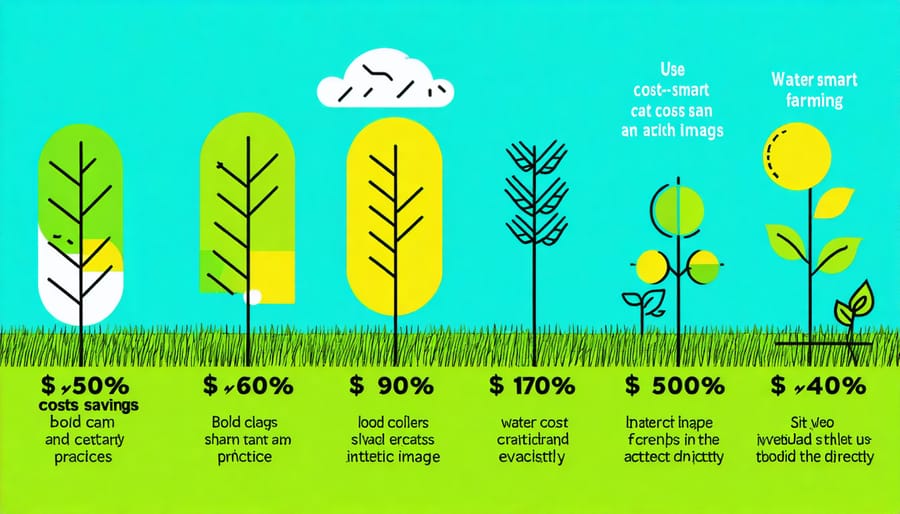
Available Grants and Support
Several federal and provincial funding programs are available to help Alberta farmers implement water-efficient practices and reduce their carbon footprint. The Canadian Agricultural Partnership (CAP) offers grants of up to $100,000 for irrigation system upgrades and water management improvements. Farmers can access these funds through the Environmental Stewardship and Climate Change Producer program, which covers 30-70% of eligible project costs.
The Alberta Carbon Offset System provides additional financial incentives for farmers who implement verified carbon reduction practices. Through this program, agricultural producers can earn carbon credits for practices that improve water efficiency and reduce emissions, which can then be sold to regulated facilities.
The Farm Water Supply Program supports producers with up to $50,000 in cost-shared funding for water source development projects, including efficient irrigation systems and water storage solutions. The Agriculture Financial Services Corporation (AFSC) also offers low-interest loans specifically designed for environmental improvements on farms.
Local watershed groups and agricultural societies frequently provide smaller grants and technical support for water conservation initiatives. The Environmental Farm Plan program, while not a direct funding source, helps farmers identify opportunities for improvements and increases their eligibility for various grant programs.
For assistance with grant applications and project planning, producers can connect with their regional agricultural fieldman or visit their local Agriculture Service Board office.
As we’ve explored throughout this article, carbon reduction strategies offer Alberta farmers practical ways to enhance both environmental stewardship and farm profitability. By implementing water-efficient irrigation systems, adopting precision agriculture techniques, and maintaining healthy soil practices, you can significantly reduce your farm’s carbon footprint while potentially improving yields.
Remember that every farm is unique, and the strategies discussed can be adapted to suit your specific needs and circumstances. Start with small, manageable changes – perhaps beginning with soil testing or upgrading one section of irrigation equipment – and build upon your successes. The agricultural community in Alberta has shown remarkable resilience and innovation in facing environmental challenges, and carbon reduction is another opportunity to demonstrate this strength.
Take advantage of available resources and support programs through local agricultural extension services and environmental initiatives. Connect with fellow farmers who have already implemented these practices to learn from their experiences. The transition to lower-carbon farming isn’t just about environmental responsibility; it’s about securing the future of agriculture in our region.
By working together and sharing knowledge, Alberta’s farming community can lead the way in sustainable agriculture while maintaining our competitive edge in the global market. Your efforts today in reducing carbon emissions will help ensure a prosperous and sustainable future for generations of farmers to come.

